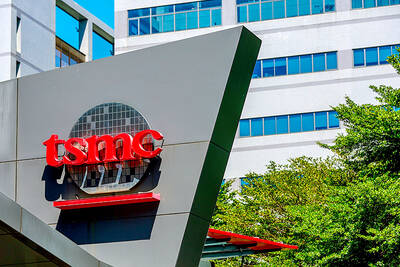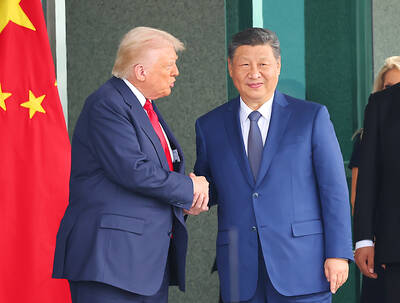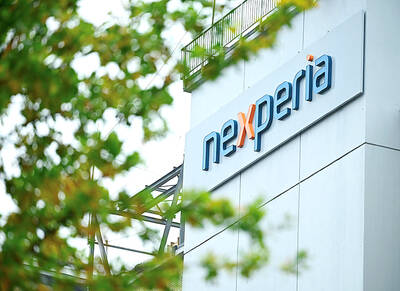Hermes Microvision Inc (HMI, 漢微科) yesterday said it expects revenues to soar as high as 80 percent sequentially this quarter, partly helped by a major client who is resuming using its inspection tools for next-generation semiconductor technology development.
Due to the slump in the semiconductor industry and growing technological barriers, customers became cautious about investing in equipment for next-generation technology, which dealt a blow to the tool-and-equipment maker’s businesses in recent quarters.
HMI’s net income last quarter plummeted 65 percent to NT$253 million (US$7.84 million), or NT$3.55 per share, from the previous quarter’s NT$726 million, or NT$10.22 a share.
On an annual basis, net income shrank 42 percent from NT$440 million, or NT$6.17 per share.
Last quarter’s results were the worst for HMI since the company made its debut on the Taipei Stock Exchange in May 2012.
“The second quarter will be a rebound quarter,” chief executive officer Jack Jau (招允佳) told an investors’ teleconference.
Revenue is expected to grow between 50 percent and 80 percent during the current quarter, Jau said.
“We will maintain margins and profitability,” Jau said.
Gross margin improved slightly to 70.5 percent last quarter from 70.1 percent the previous quarter.
“That [major] customer has come back,” Jau said.
HMI, which holds an 85 percent share in the world’s e-beam inspection market, counts the world’s two biggest semiconductor equipment spenders — Intel Corp and Taiwan Semiconductor Manufacturing Co (TSMC, 台積電) — as its biggest customers.
HMI is seeing an uptrend of using e-beam inspection tools in advanced technologies, but there is the uncertainty about the timing of revenue booking, as customers are still cautious on capital spending amid decelerating end demand for electronic devices such as mobile phones and tablets, he said.
The second half of this year will be better than the first half, he said.
For the full year, “a double-digit percent [annual] growth [in revenue] will be achievable,” he said.
The forecast is largely in line with the forecast of JPMorgan analyst Rahul Chadha.
“We believe HMI is on track for high-teen percent in revenue growth this year, with some upside potential if Intel’s 7nm [nanometer] tool shipments recover strongly in the second half of 2016,” Chadha said in a report on April 1.
To alleviate concerns about potential effect of customers’ reusing current inspection tools for next-generation production, HMI said that the impact on revenue was not expected to be significant.
TSMC last week said that about 95 percent tools for its 10nm technology could be reused in developing 7nm technology.
“One logic fab customer tends to reuse e-beam inspection tools on 7nm [technology ramp] from 10nm… So far, I do not really see customers moving all their tools from one production line to another production line,” Jau said.
HMI is also developing new inspection tools to help manufacturers find smaller defects as chip geometry continues to shrink.
Shares of HMI surged 4.18 percent to NT$822 in Taipei trading yesterday, ending five straight losing sessions.

RUN IT BACK: A succesful first project working with hyperscalers to design chips encouraged MediaTek to start a second project, aiming to hit stride in 2028 MediaTek Inc (聯發科), the world’s biggest smartphone chip supplier, yesterday said it is engaging a second hyperscaler to help design artificial intelligence (AI) accelerators used in data centers following a similar project expected to generate revenue streams soon. The first AI accelerator project is to bring in US$1 billion revenue next year and several billion US dollars more in 2027, MediaTek chief executive officer Rick Tsai (蔡力行) told a virtual investor conference yesterday. The second AI accelerator project is expected to contribute to revenue beginning in 2028, Tsai said. MediaTek yesterday raised its revenue forecast for the global AI accelerator used

Taiwan Semiconductor Manufacturing Co (TSMC, 台積電) has secured three construction permits for its plan to build a state-of-the-art A14 wafer fab in Taichung, and is likely to start construction soon, the Central Taiwan Science Park Bureau said yesterday. Speaking with CNA, Wang Chun-chieh (王俊傑), deputy director general of the science park bureau, said the world’s largest contract chipmaker has received three construction permits — one to build a fab to roll out sophisticated chips, another to build a central utility plant to provide water and electricity for the facility and the other to build three office buildings. With the three permits, TSMC

TEMPORARY TRUCE: China has made concessions to ease rare earth trade controls, among others, while Washington holds fire on a 100% tariff on all Chinese goods China is effectively suspending implementation of additional export controls on rare earth metals and terminating investigations targeting US companies in the semiconductor supply chain, the White House announced. The White House on Saturday issued a fact sheet outlining some details of the trade pact agreed to earlier in the week by US President Donald Trump and Chinese President Xi Jinping (習近平) that aimed to ease tensions between the world’s two largest economies. Under the deal, China is to issue general licenses valid for exports of rare earths, gallium, germanium, antimony and graphite “for the benefit of US end users and their suppliers

Dutch chipmaker Nexperia BV’s China unit yesterday said that it had established sufficient inventories of finished goods and works-in-progress, and that its supply chain remained secure and stable after its parent halted wafer supplies. The Dutch company suspended supplies of wafers to its Chinese assembly plant a week ago, calling it “a direct consequence of the local management’s recent failure to comply with the agreed contractual payment terms,” Reuters reported on Friday last week. Its China unit called Nexperia’s suspension “unilateral” and “extremely irresponsible,” adding that the Dutch parent’s claim about contractual payment was “misleading and highly deceptive,” according to a statement